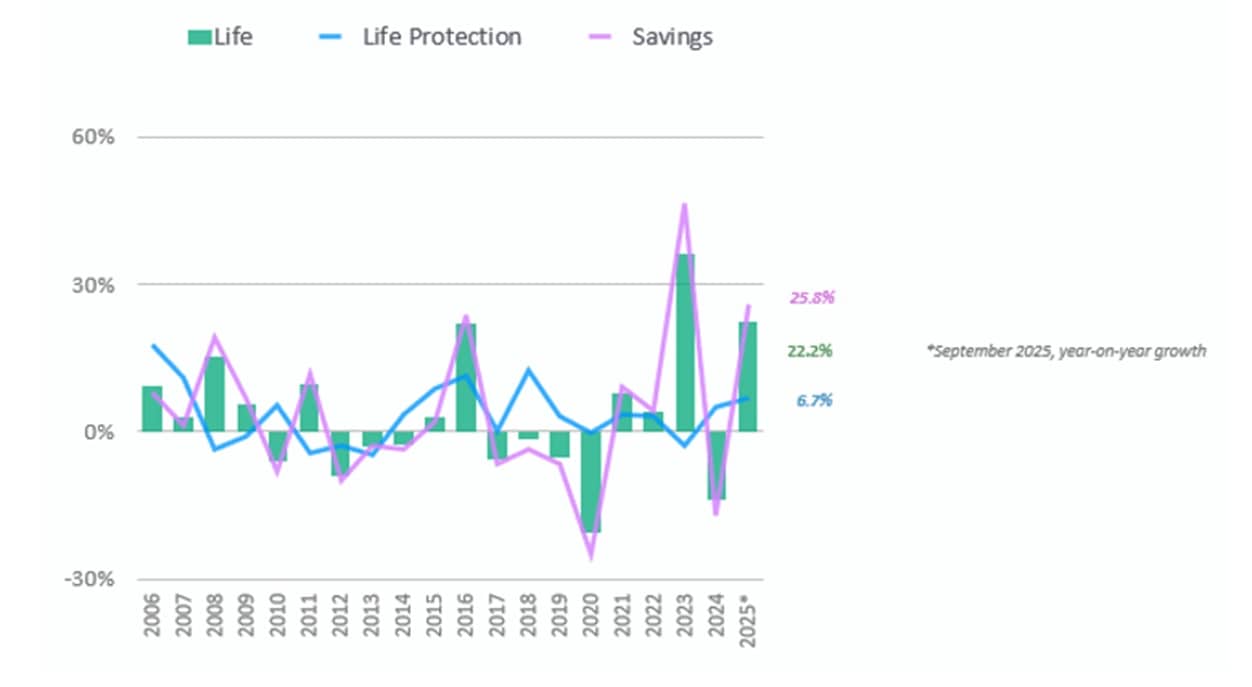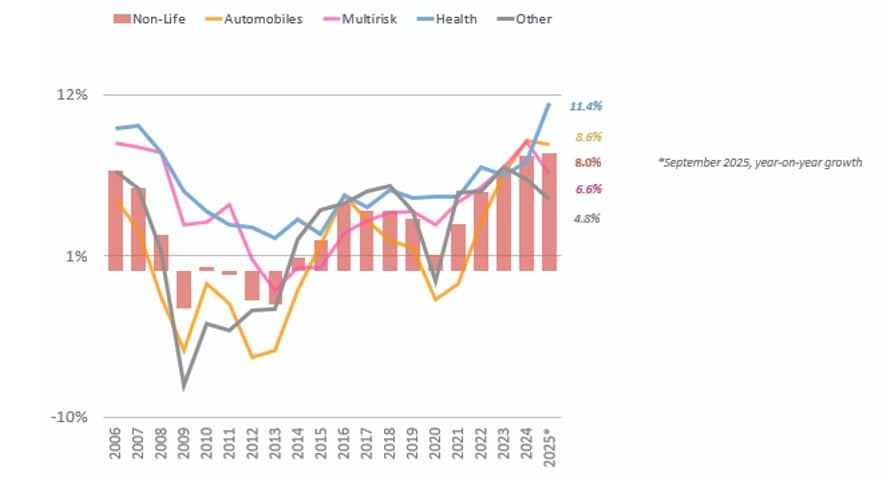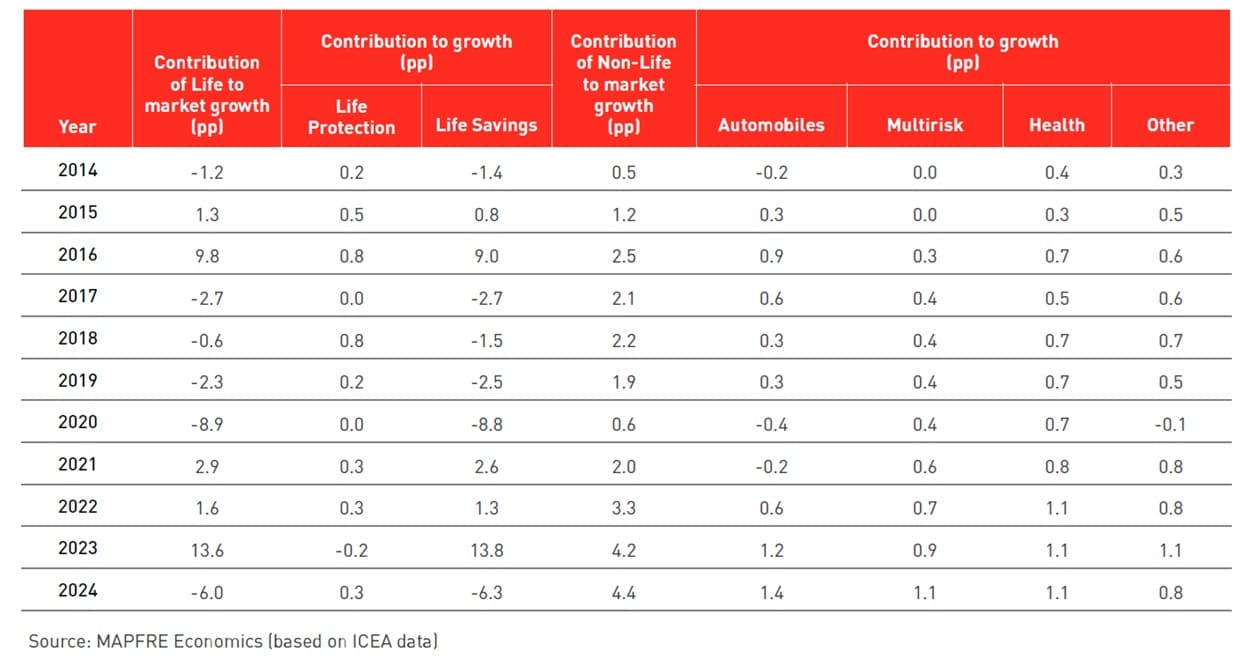The Spanish Insurance Market in 2024
Author: MAPFRE Economics
Summary of the conclusions of the
MAPFRE Economics report
The Spanish insurance Market in 2024
Madrid, Fundación MAPFRE, july 2025
Following the decline recorded in 2024, during the first nine months of 2025 the Spanish insurance sector posted a 13.6% increase in written premiums, driven by the recovery of the Life savings segment (up 25.8%), which contrasts with the sharp drop seen in this line the previous year (-17.0%). In terms of managed savings, Life technical provisions rose by 4.65 % compared with the same period a year earlier, reaching 219.0 billion euros in September 2025 (see Chart 1).
Chart 1. Trends in direct life insurance in Spain
(annual variation, %)

Meanwhile, the Non-Life segment has continued its uninterrupted positive performance since 2014, recording an 8.0% year-on-year increase in premium volume in September 2025, to 37.2 billion euros, with favorable results across most lines of business. In this regard, the two largest lines, Auto and Health, saw above-average growth, with rates of 8.6% and 11.4%, respectively, driven by ongoing adjustments to premium rates aimed at offsetting higher operating costs (see Chart 2).
Chart 2. Trends in direct Non-Life insurance in Spain
(annual variation, %)

The context for the Spanish insurance market in 2024 was marked by an environment of economic growth supported by private consumption, a strong labor market, and still-restrictive financial conditions, although interest rates began to decline gradually in the second half of the year. Average inflation for the year stood at 2.8% (3.5% in 2023). This environment largely favored Non-Life insurance activity, while the Life segment, especially its savings component, experienced a decline after the exceptional growth seen the previous year. Aggregate premium volume for the Spanish insurance sector reached 75.1 billion euros in 2024, representing a decline of 1.6 % (+17.8% in 2023), explained mainly by the drop in Life insurance premiums.
Life premium issuing totaled 28.8 billion euros in 2024, down by 13.7% (up by 36.0% in 2023). Life savings insurance was the main contributor to this decline, with a year-on-year drop of 17.0%. In contrast, Life Protection revenue grew by 4.8%, reaching 5.3 billion euros, driven by the gradual recovery of credit activity. Non-Life lines, meanwhile, generated 46.4 billion euros in premium income, representing an increase of 7.8% (6.8% in 2023). All lines contributed positively to the growth of this segment, with the Automobile line accounting for 1.4 pp. Over the 2014–2024 period, however, Health insurance showed the greatest contribution to growth in the Non-Life line, standing at 8.1 pp, followed by Multirisk insurance with 5.3 pp, and Motors with 4.8 pp (see Table 1).
Table 1. Contribution to Life and Non-Life insurance market growth
(percentage points, pp)

Automobile insurance maintained a growth rate close to 10% in 2024, closing the year with a premium volume of 13.2 billion euros, up 8.9% on the previous year (6.6% in 2023). This performance was influenced by the rise in the average premium, which reached 388 euros, 7.0% higher than in 2023, as well as by the increase in insured vehicles, which, at 34 million vehicles, was up 1.7%. On the other hand, the technical result for the line of business improved slightly in 2024, even though the combined ratio for Automobile insurance remains above 100%, at 101.4%, which is 0.2 pp below the figure recorded in 2023. This improvement was made possible by a reduction in expenses (-0.9 pp), as the loss ratio rose again to 81.6%, that is, 0.7 pp higher than in the previous year. During the first nine months of 2025, the industry’s business volume continued to perform well, with an 8.6% increase in premiums year on year.
This line of insurance will be affected in the near future by a regulatory change that is in the final stages of its parliamentary process: the bill that modifies the consolidated text of the Motor Vehicles Third-Party Liability and Insurance Act. One of the act’s objectives is to transpose Directive 2021/2118 relating to third-party liability insurance for the circulation of motor vehicles, and to supervise the obligation to insure this liability. Transposition of the directive will also improve the authorities’ oversight of the existence of insurance. The act also seeks to incorporate improvements proposed by the Commission for Valuation System Monitoring into the valuation of indemnifications for personal injury caused by traffic accidents.
Health insurance grew again in 2024, with a 7.4% rise in written premiums (6.5% in 2023), reaching 12.1 billion euros. The number of policyholders also increased, rising to 14.2 million, 1.9% more than in 2023. In terms of profitability, the combined ratio for this line of business stood at 95.8% in 2024, up from 94.1% the previous year, due to the increased frequency of healthcare service use by policyholders and the higher average cost of benefits. Based on preliminary data through September 2025, this line of business’s revenue continues to show an upward trend, with a year-on-year increase of 11.4%.
Multirisk insurance is the third-largest Non-Life insurance line of business by premium volume, with a 21.6% market share in 2024 and premium revenue of 10.0 billion euros, 8.8% higher than the previous year (6.8% in 2023). All the modalities of this insurance line increased their premium volume in 2024. Home Multirisk obtained the highest increase (9.6%), followed by Condominium (8.7%), Commercial (7.2%), and Industrial (7.0%). It should be noted that in 2024 the combined ratio for the entire sector improved, standing at 91.9%, thanks to a decrease in claims and a slight improvement in expenses and financial results. The figures published for the first nine months of 2025 show an increase of 6.6%, with notable increases in Home and Condominium insurance.
Finally, the Life insurance business recorded a total premium volume of 28.8 billion euros in 2024, down by 13.7% compared to the extraordinary increase of 36.0% achieved in 2023. Life Protection insurance performed positively, with 4.8% growth, while total Savings/Retirement premiums fell by 17.0%, with a fairly widespread decline across almost all product categories. Only the Conversion of Assets into Life Annuity segment saw slight growth of 0.4%. However, there was a slight upturn in the number of insured parties, with 2.24% total growth. Based on the data published for the first nine months of 2025, Life premiums experienced year-on-year growth of 22.2%, with a significant recovery in Life Savings (25.8%) and a 6.7% increase in Life Protection.
The number of insurance companies operating in the Spanish market in 2024 continued to decrease, as a result, amongst other factors, of the reorganization of bancassurance agreements and sector consolidation processes. Thus, at the end of 2024, the Administrative Register of Insurance Companies (RAEA – Registro Administrativo de Entidades Aseguradoras) reported the existence of 187 insurance companies, compared to 194 in 2023. MAPFRE Group remains the top Spanish insurance group worldwide, with premium volume totaling 28.1 billion euros in 2024, a 4.5% increase over the previous year, of which 63.5% was generated outside of Spain (see Chart 3).
Chart 3. Ranking of the leading Spanish insurance groups active internationally by premium volume
(millions of EUR)

As regards the overall technical performance of the Spanish insurance industry in 2024, the combined ratio saw an increase of 2.1 pp, standing at 107.3%, compared to 105.2% in 2023. The expense ratio increased 1.3 pp, slightly above the loss ratio, which increased 0.8 pp. Meanwhile, the combined ratio for the Non-Life insurance segment stood at 94.6% in 2024, a slight improvement of -0.2 pp with respect to the value registered in 2023 (94.8%). This result reflects a 0.2 pp increase in the loss ratio, to 71.6%, and a 0.3 pp decline in the expense ratio (see Chart 4).
Chart 4.Trends in the total combined ratio
(total combined ratio, %; annual change in combined ratio, pp)

Total investment volume by insurance companies in the Spanish market in 2024 rose to 320.3 billion euros, down by 3.6% compared to the previous year. An analysis of the investment portfolio broken down by asset type shows that fixed income securities maintained their relative weight over the 2014–2024 period, from 68.1% in 2014 to 67.8% in 2024 (47.7% sovereign and 20.0% corporate), but had yet to recover their 2019 pre-pandemic highs.
The return on financial investments in the insurance industry stood at 4.6% in 2024 (0.6 pp higher than a year earlier), driven by the interest rate environment that has stabilized following the rate hikes by the European Central Bank (ECB) in recent years, as observed in the yields across different maturities of Spanish debt (see Chart 5).
Chart 5. Return on the insurance industry’s financial investments
(financial income/average investment, %; risk-free interest rate, %)

Regarding aggregate profitability indicators, the Spanish insurance sector generated a profit of 6.4 billion euros in 2024, representing a 16.5% increase in the non-technical account compared to the previous year. Thus, the performance of the insurance business in 2024 yielded a return on equity (ROE) of 14.3%, 1.1 pp more than in 2023. Likewise, the sector’s profitability, measured as the return on assets (ROA)—the ratio of annual results to average total assets—stood at 1.9%, with a slight increase of 0.17 pp compared to the previous year.
The drop in the volume of Spanish insurance premiums, on account of the decline in the Life business, was reflected in the decrease in the sector’s penetration indicator in the economy, which stood at 4.72%, down by 0.37 pp compared to 2023. In particular, the penetration rate for Life insurance fell by 0.42 pp in 2024 to 1.81%, while the penetration rate for Non-Life insurance stood at 2.91%, down slightly by 0.04 pp compared to 2023.
Conversely, the density of insurance in Spain (premiums per capita) stood at 1,531.2 euros in 2024, representing a decline of 39.2 euros compared with the previous year. This decrease is attributable to the Life segment, where per-capita premiums totaled 586.7 euros (99.4 euros less than the year before), driven mainly by the performance of Life Savings insurance density, which reached 479 euros per capita in 2024 (103.4 euros less than in the prior year). In turn, the density of Non-Life insurance stood at 944.4 euros, an increase of 60.2 euros over 2023 (see Chart 6).
Chart 6. Trends in the Spanish insurance market
(penetration vs. depth)

A detailed analysis of the different business lines and structural trends in the last decade can be found in the report The Spanish Insurance Market 2024 , prepared by MAPFRE Economics and available at the following link:




